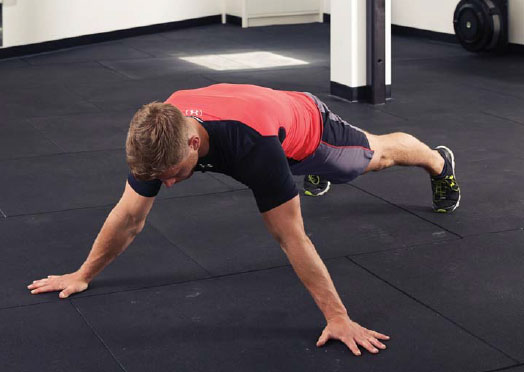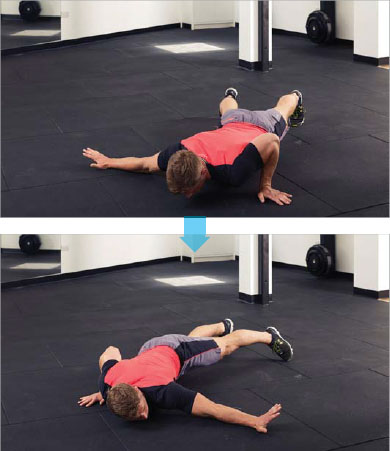BUILD NEW MUSCLE
USING ADVANCED PRESS UP MOVES
BLITZ YOUR BELLY
WITH PRESS UP HIIT CIRCUITS
BE INJURY PROOF
BY STRENGTHENING YOUR SHOULDERS
Could press-ups be the perfect exercise? For one thing, you can do them anywhere and any time – but what makes the press-up one of the very best muscle-building moves is that there are so many variations on the classic move that it’ll enable you to build a stronger, more impressive upper body even if you don’t have much time or access to any equipment. Here’s all you need to know.
The press-up is probably the most popular bodyweight move in the world. That’s partly because it can be performed anywhere, without the need for much space or any kit. But above all it’s effective, working your chest, core, triceps and shoulders, if you do it right. What’s more, this classic move has a huge number of variations that will work the muscles of your upper body in new and challenging ways to promote new muscle mass growth, improve shoulder stability and mobility, and burn body fat to reveal a more defined torso.
So if you haven’t done a press-up since it was your punishment at school for forgetting your PE kit, it might be time for you to reconsider your opinion on it and factor it back into your training programme. Read on to discover how to perform the perfect press-up and find out how you can use the move more effectively to build your best ever body.
PERFORM THE PERFECT PRESS UP
Master the basic movement pattern and start reaping the rewards

“The ability to crank out countless press-ups might seem impressive, but if you’re serious about adding upper-body size and strength then quality is far more important than quantity,” says trainer James Stark (pictured above). “If you get your press-up form absolutely right, every single rep will help you add size and strength.” Follow these form tips to master the movement and add muscle faster.
❶ HAND WIDTH
HOW Place your hands shoulder-width apart with arms straight and so your shoulders, elbows and wrists line up.
WHY This position, with all the joints of your arms aligned, works your muscles without placing excess stress on the joints.
❷ HAND POSITION
HOW Your fingers should be slightly splayed and pointing forward, with your hands forming right angles with your forearms.
WHY Maintaining a strong wrist position keeps your arm joints aligned to minimise joint stress and form the most stable set-up.
❸ ELBOW MOVEMENT
HOW Initiate the move by bending your elbows to lower your chest towards the ground.
WHY Flaring your elbows out to the sides works the chest harder but ups pressure on the shoulders. Keeping them at your sides works the triceps more.
❹ IDEAL HIP HEIGHT
HOW Your hips should remain in line with your shoulders for the entirety of the set.
WHY Holding your hips up keeps your body stable, which allows your muscles to focus on performing high-quality reps rather than on stabilising your torso.
❺ FOOT WIDTH
HOW Keep your feet hip-width apart. Placing them farther apart makes it easier and bringing them together makes it harder.
WHY The closer together your feet the less stable your body, which means your muscles must work harder each rep.
❻ DEPTH OF REPS
HOW The closer you can get your chest to the floor the better because this makes the working muscles move through a full range of motion.
WHY The deeper you can go the more muscle fibres you activate. Keep reps slow to work them harder.
Test your press-up best
10 MINUTE PUMP UP
SIZE & STRENGTH
WHAT This high-intensity ten-minute three-move circuit will flood your upper-body muscles with blood to create a huge pump and thoroughly fatigue your muscle fibres while keeping your heart rate high for both a muscle gain and a fat loss effect.
HOW Do as many diamond press-ups as you can, then rest for 20 seconds. Then do as many normal press-ups as possible, then rest for 20 seconds. Finally do as many wide press-ups as possible then rest 60 seconds. Repeat this circuit four times.
30 MINUTE CHALLENGE
ENDURANCE
WHAT This half-hour EMOM (every minute on the minute) workout will increase your upper body’s muscular endurance by taxing the muscles hard, resting, then going again through the process of accumulated fatigue.
HOW In the first minute and subsequent odd-numbered minutes do ten normal press-ups and rest for the remainder of the minute. In even-numbered minutes do ten reps of another press-up variation that targets the shoulders or triceps more, then rest for the remainder of the minute. So you’ll do a total of 300 press-ups in just 30 minutes to improve muscular strength and endurance. If ten reps feels too easy, do 12-15 reps in each minute.
THE SIMPLE TWEAKS FOR SERIOUS GAINS
Up the ante, adjust the angles and add muscle

Traditional press-ups work your chest, triceps and shoulders, but some simple tweaks to the move can shift the emphasis to one of these muscles, while lessening the involvement of the other two. Try these three variations to increase the workload on your shoulders, triceps and chest respectively, helping you build a stronger and more impressive upper body.
❶ TARGET SHOULDERS
MOVE HINDU PRESS UP

WHY Elevating your hips places more of your bodyweight on your shoulders and forces them work harder.
HOW Start in a press-up position then raise your hips so your body forms a V-shape. Brace your core and bend your elbows to lower your chest towards your hands, moving your head and torso forwards in a smooth arc. Keep moving your upper body forwards until your eyes are looking forward and your chest is up. Press straight back up to return to the start position.
❷ TARGET TRICEPS
MOVE DIAMOND PRESS UP

WHY Having your hands closer together limits how wide you can take your elbows and how much your chest can get involved, so your triceps must take on more of the workload.
HOW Start in the normal press-up position but bring your hands together so that your thumbs and forefingers form a diamond. Lower your chest to the ground, then press back up powerfully.
❸ TARGET CHEST
MOVE WIDE PRESS UP

WHY Taking your hands out wide – they should be double shoulder-width apart – reduces the involvement of your triceps and shoulders so your chest has to do more work to lower and then lift your body.
HOW Start in the normal press-up position but with your hands out wide. Bend your elbows and lower your chest down towards the ground. Focus on a slow and controlled lowering phase to minimise stress on your shoulders. Once you are as low as you can comfortably go, press powerfully back up to the start.
Get intense by ending your workout with press-up burpees

HOW DO TO IT
Stand tall, then drop down so your hands are on the floor and your knees are tucked in to your chest. Kick your legs backwards to get into the press-up position then perform the move with perfect form. Bring your legs back in to your chest, jump up and land back in the start position.
PRESS UP BURPEE CHALLENGES
MINUTE MAYHEM
Do as many reps as you can in a minute. This is simple and effective. Working against the clock will help to push your body out of its comfort zone. Make a note of your score and try to beat it next time.
BURPEE LADDER
Do one press-up burpee, then do another rep, but this time do two mid-rep press-ups. Continue that pattern, adding one press-up each time, until you reach failure. Aim to beat your score next time.
BURPEE BATTLE
Do this with a training partner. You do one rep, then your partner does one rep. You do two, then your partner does two. Keep adding a rep until one of you fails.
ADVANCED VARIATIONS
“Part of the beauty of the press-up is you can make the move much harder as you become stronger and better at it by making small yet significant tweaks to work your muscles in new and more challenging ways,” says Stark.
“Once you can comfortably perform 15 to 20 traditional press-ups with perfect form, try these three advanced variations, focusing on smooth and controlled movement patterns. Do three sets of eight to 12 reps.”
❶ CORKSCREW PRESS UP

WHY Starting with your hands further forward works your shoulders harder, while adding a hip rotation with each rep recruits your core and lower abs muscles.
HOW Start in a press-up position but with your hands in front of your shoulders. As you bend your elbows to lower your chest towards the floor, twist your hips to one side and then back the other way, keeping your core engaged throughout. Then press back to the start.
❷ ARCHER PRESS UP

WHY Start in a normal press-up position but as you lower yourself down reach one arm out to the side, resting on your wrist. Return to the start. Repeat with your other arm.
HOW This variation tests those small but important stabilising muscles of the shoulder that must work hard to support your bodyweight as you lower then lift your torso repeatedly. It also works your core muscles, which are forced to maintain torso stability with each rep.
❸ DIVEBOMBER PRESS UP

WHY This move is a slightly more difficult version of the Hindu press-up. It works your shoulders hard, as well as your core to maintain torso stability.
HOW Start in a press-up position then raise your hips and bend your elbows. Lower your head and chest down and forwards moving your torso in a smooth arc to raise up your head and chest. Reverse the movement to return to the start position.